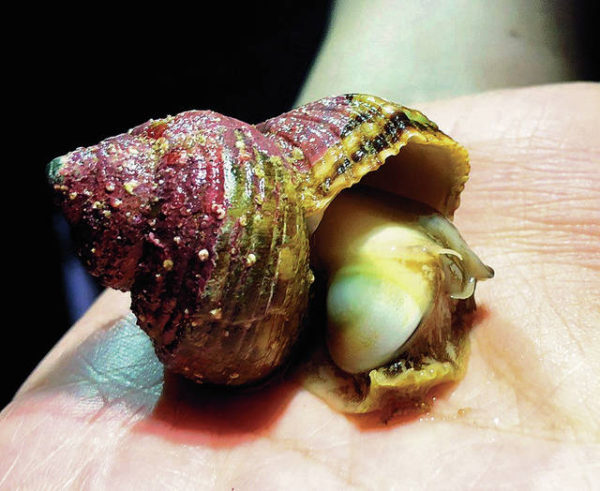Published in the Ocean Watch column, Honolulu Star-Advertiser © Susan Scott
February 2, 2019
During my walks on North Shore beaches, I pick up so-called cat’s eyes, the round, white trap doors that were once attached to certain sea snails. The cat’s eyes I find vary in size and wear-and-tear, but all have the same shape and consistency, perfect for my art projects.
I collect these little gems for only an hour or so on the occasional weekend, but even so, I have hundreds.
I wasn’t sure which species produces these buttonlike treasures until recently when I found a live one in a tide pool. When I picked up the snail to examine it, there was an operculum exactly like the ones in my collection, only this one was still attached to the snail’s foot. (Operculum, plural opercula, meaning lid, is the Latin name for cat’s eyes.) The snail withdrew into its fortress, slamming the door behind it.
 The white disk visible on the foot of this live Hawaiian turban snail
The white disk visible on the foot of this live Hawaiian turban snail
detaches when the snail dies, washing up on the beach as a so-called cat’s eyes.
Courtesy Craig Thomas
The species is the Hawaiian turban, or pupu mahina, meaning moon snail, so called, according to the Hawaiian dictionary, because the operculum is round like the moon. Hawaiians also called the 3-inch-long snails ailea. The mollusk’s scientific name, Turbo sandwicensis, reflects the creature’s endemic status.
Hawaii hosts five species of turban snails, the Hawaiian turban being the largest. The smallest, at 2 millimeters (0.08 inches) tall, is barely visible to the naked eye.
Hawaiian turbans are commonly found under stones in shallow water to depths of about 60 feet. The animals eat algae and are crucial in keeping seaweed in check on our reefs.
Turban snails were named for their resemblance to the headdress and are not to be confused with similar snails called tops.
Top snails have a flat base with the shell above rising to a point, like the spinning toy these snails were named after. People have killed both turban and top snails throughout the South Pacific to make buttons from their mother-of-pearl interiors.
Top snails’ opercula are thin, consisting of flimsy, fingernail-like material. The solid turban snails’ operculua, however, fit so snugly into their shells’ openings that even predatory cone snails can’t get in to sting and eat the snail inside.
Not all snails have opercula that close the shell. In conchs, family Strombidae, the snails use their claw-shaped opercula like a pole vault, pushing it into the ocean floor to leap forward.
A reader named Joe emailed, “Do the turban shells die when they lose these doors, or do they expel them as they get older and larger?”
I explained that the operculum is part of the muscular foot, so as the snail grows, so does its trap door. All the cat’s eyes we find on the beach come from snails that have died.
To which Joe replied, “There must be a lot of death out there.”
Indeed, there is. And that means, of course, there’s also a lot of life.